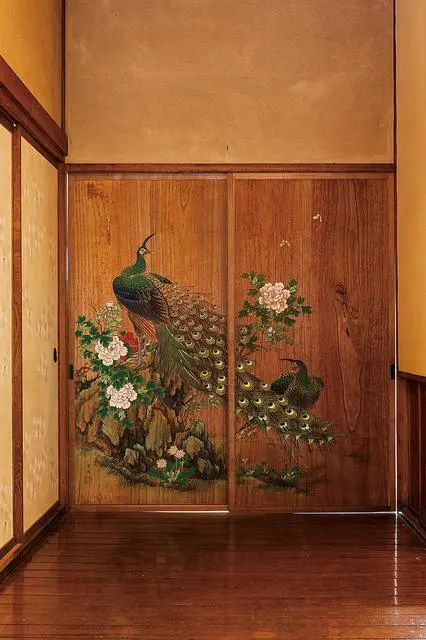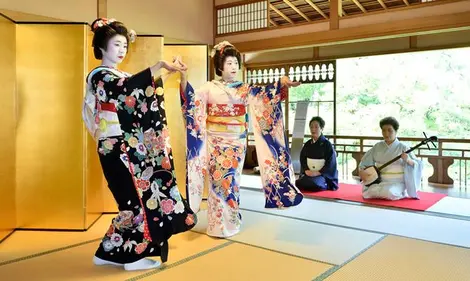Villa Saito 旧齋藤家別邸
Tradition is good
A symbol of Niigata's prosperity at the beginning of the 20th century, Villa Saito is a remarkable cultural heritage of the port city; so much so that citizens mobilized strongly in the early 2000s to prevent its disappearance. Since its opening to the public in 2012, the subtle harmony linking the villa and its garden has been accessible to all.
A family home
At the beginning of the Meiji era (1868-1912), the Saito family , one of the three wealthiest families in the port city of Niigata, diversified their activities by taking over the management of a shipping company, after having developed their sake business ten years ago. Leading a fleet of Kitamaebune , cargo ships linking Osaka to Hokkaido by the Sea of Japan, the Saito zaibatsu (group of companies) quickly generates significant profits. These allow the family clan to acquire land and invest in real estate values in the region, thus contributing to the modernization and vitality of the city. On the strength of this fortune, Kijuro Saito IV had a summer villa built on a plot of 4,500 m 2 between 1917 and 1920. Although occupied by American forces after the Second World War, the villa once again became a family residence in 1953; bought by Kaichiro Kagata (1900-1978). Three generations of Kaga follow one another in the villa. In 2005, alerted by the imminent sale of the house and its possible dismantling, citizens of Niigata mobilized and worked actively to preserve it. Fundraisers, awareness campaigns and petitions are not in vain. In 2009, the villa became the property of the municipality and was opened to the public three years later.
Read: The Katsura villa in Kyoto
A perfect symbiosis
The elegant villa, second home of the Saito family, is designed to be both the pleasant holiday resort of the family clan and the setting for receptions where distinguished guests such as politicians, celebrities and business leaders rub shoulders . To be this much desired place of summer rest, the villa, facing north, is inserted in a lush green setting ; protecting it from heat and light. The vast complex includes a two-storey wooden house, a warehouse, a tea house and a splendid traditional garden.
In the sukiya-zukuri style , the house is the perfect example of modern Japanese architecture from the Taisho era (1912-1926) and is inspired by the aesthetics of tea houses. Kijuro Saito IV involved the best craftsmen for the realization of the luxurious interior decoration . The stair railings, the sculptures of the sleepers, the paintings, the heart-shaped windows are all evidence of an assertive search for elegance and the very particular care given to detail. The naturalistic paintings with motifs of peonies, roosters and peacocks, although centuries old, still radiate their precious brilliance. The large openings on the outside of the first and second levels allow you to appreciate the panoramic view of the garden.
See : The Nomura Residence in Kanazawa
From each room, different landscapes are offered to you. You should know that the house and the garden have been thought out and designed as a whole, inseparable from each other. From the villa, sitting on a tatami, your gaze, inexorably drawn to the distance, is as if deceived by this visual impression of continuity between interior and exterior, this perfect harmony between the villa and the green garden. The Tokyo landscaper, Kamekichi Matsumoto , took into account the topography and the nature of the terrain when laying it out. Established on ancient sand dunes and organized around a central pond, the hilly garden presents more than 80 varieties of trees (pines, plum trees, bamboos, maples, etc.) and shrubs.
Maintaining traditions
The Kaga family regularly offered tea ceremonies in the villa, open to all; making the property a place of cultural exchange in the eyes of the population. This has most certainly contributed to this strong momentum of the inhabitants of Niigata for its safeguard. Villa Saito still maintains this tradition of tea tasting within its walls. It offers matcha tea tastings and small sweet treats for 500 yen (about €4) during the visit.
Read also : What is it to be a geisha?
Another, rarer activity is offered there as part of the Hanamachi Chaya program, set up by the municipality. On certain dates, it is possible to be entertained by Furumachi Geigi in Villa Saito. During the Edo period (1603-1868), the Furumachi district was one of the largest geisha districts in the country . During this program, the Furumachi Geigi, still a dozen to this day in Niigata okiya , entertain visitors with Nihon Buyo dances , to the sound of shamisen and traditional songs. They also play taruken with you, a variation of the rock-paper-scissors game set to the sound of a drum where the winner hits the drum twice while the loser spins around. A simple and very funny game!
Address, timetable & access
Address
Phone
+81 (0) 252 108 350Timetable
Take the Inuyasha Sightseeing Bus from Niigata Station, get off at the Museum of Northern Cultures stop, then walk 2 min.Price
Adult: 300 yen (3€). Child: 100 yen (1€) . Free on weekends and public holidays.Access
Open from 9:30 a.m. to 5 p.m. Closed on Mondays.Website
http://saitouke.jp/






























